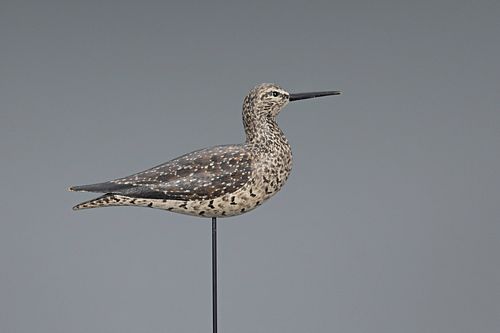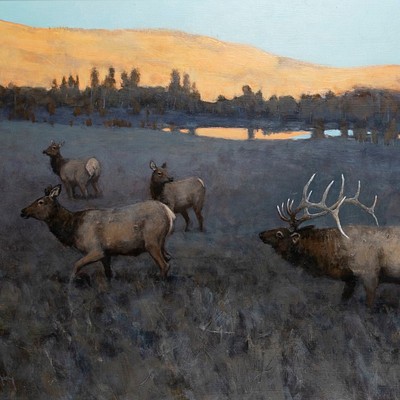Outstanding Willet Decoy, A. Elmer Crowell (1862-1952)
Lot 171
About Seller
Copley Fine Art Auctions
20 Winter Street
Pembroke, MA 02359
United States
Founded in 2005, Copley Fine Art Auctions is a boutique auction house specializing in antique decoys and American, sporting, and wildlife paintings. Over the course of the last two decades, the firm has set auction records for not only individual decoy makers, but also entire carving regions. Copley...Read more
Categories
Estimate:
$25,000 - $35,000
Absentee vs Live bid
Two ways to bid:
- Leave a max absentee bid and the platform will bid on your behalf up to your maximum bid during the live auction.
- Bid live during the auction and your bids will be submitted real-time to the auctioneer.
Bid Increments
| Price | Bid Increment |
|---|---|
| $0 | $50 |
| $1,000 | $100 |
| $2,500 | $250 |
| $5,000 | $500 |
| $10,000 | $1,000 |
| $25,000 | $2,500 |
| $50,000 | $5,000 |
About Auction
By Copley Fine Art Auctions
Jul 23, 2020
Set Reminder
2020-07-23 10:00:00
2020-07-23 10:00:00
America/New_York
Bidsquare
Bidsquare : The Sporting Sale 2020
https://www.bidsquare.com/auctions/copley/the-sporting-sale-2020-5244
Copley Fine Art Auctions The Sporting Sale 2020 Copley Fine Art Auctions cinnie@copleyart.com
Copley Fine Art Auctions The Sporting Sale 2020 Copley Fine Art Auctions cinnie@copleyart.com
- Lot Description
Outstanding Willet
A. Elmer Crowell (1862-1952)
East Harwich, MA, c. 1910
13 in. long
An exemplary full-bodied willet with a split tail and glass eyes. The carving is branded "P.W.W." twice for Parker Williams "Buck" Whittemore (1872-1959). Whittemore is featured in “Elmer Crowell: Father of American Bird Carving” as one of the carver’s important early benefactors. He was a Harvard graduate, class of 1895, where he captained the baseball team. A manufacturer of railroad cars, Whittemore lived in West Gloucester and Boston’s Back Bay. He also had an estate in Wareham, Massachusetts, and hunted on Cape Cod. Known for their bold forms and exceptional stippled-paint patterns, Crowell took tremendous care in carving these early shorebird rigs for his affluent patrons. The basis of the pattern, especially the drawn-back head, is comparable to Crowell’s calling yellowlegs. The brief period during which he carved these life-like working decoys was just prior to the passing of the Migratory Bird Treaty Act of 1918.
A "Nelson" stamp, denoting the Grant Nelson Collection, is displayed on the underside along with an early collector's sticker with number "1" designation. This sticker likely indicates the number one shorebird from the collection of Winsor White. White was an early collector from Duxbury, Massachusetts, who put together one of the great early decoy collections back in the 1950s and influenced Dr. George Ross Starr, also from Duxbury. White had exceptional taste, owning not one, but two Lothrop Holmes mergansers.
Excellent original paint with minor gunning wear and some minor touch-up to the original bill, and two tiny flakes on right side.
Provenance: Parker W. "Buck" Whittemore Rig
Grant Nelson Collection
Literature: Stephen B. O'Brien Jr. and Chelsie W. Olney, "Elmer Crowell: Father of American Bird Carving," Hingham, MA, 2019, pp. 140-141, rigmate illustrated.
John and Shirley Delph, "New England Decoys," Exton, PA, 1990, p. 153, similar decoy illustrated.
Linda and Gene Kangas, “Connecting the Dots: Exploring the provenance of Elmer Crowell's decoys,” Decoy Magazine, March/April 2010, p. 33, rigmates illustrated.
Copley Fine Art Auctions, LLC, “The Harry V. Long Collection of A. Elmer Crowell Decoys,” The Sporting Sale, Boston, MA, 2009, lot 64, pp. 24, 73 and dust jacket cover, Long calling yellowlegs decoy illustrated.Please email condition report requests to colin@copleyart.com. Any condition statement given is a courtesy to customers, Copley will not be held responsible for any errors or omissions. The absence of a condition statement does not imply that the lot is in perfect condition.Condition
- Shipping Info
-
Shipping info
Copley Fine Art Auctions does not handle the shipping of any items. Shipping is the sole responsibility of the buyer. Once your payment has cleared, and we have received your authorized shipping release form items may be released for shipment. Copley Fine Art Auctions, LLC shall have no liability for any loss or damage to such items. Buyers should allow up to four weeks for shipment.Please be aware that internet bidders may NOT not pick up their items at the sale. Items will be available for pick up by appointment or by shippers five days after the sale.
-



 EUR
EUR CAD
CAD AUD
AUD GBP
GBP MXN
MXN HKD
HKD CNY
CNY MYR
MYR SEK
SEK SGD
SGD CHF
CHF THB
THB















